- New Sailboats
- Sailboats 21-30ft
- Sailboats 31-35ft
- Sailboats 36-40ft
- Sailboats Over 40ft
- Sailboats Under 21feet
- used_sailboats
- Apps and Computer Programs
- Communications
- Fishfinders
- Handheld Electronics
- Plotters MFDS Rradar
- Wind, Speed & Depth Instruments
- Anchoring Mooring
- Running Rigging
- Sails Canvas
- Standing Rigging
- Diesel Engines
- Off Grid Energy
- Cleaning Waxing
- DIY Projects
- Repair, Tools & Materials
- Spare Parts
- Tools & Gadgets
- Cabin Comfort
- Ventilation
- Footwear Apparel
- Foul Weather Gear
- Mailport & PS Advisor
- Inside Practical Sailor Blog
- Activate My Web Access
- Reset Password
- Customer Service

- Free Newsletter


Blue Jacket 40 Used Boat Review

Catalina 270 vs. The Beneteau First 265 Used Boat Match-Up

Ericson 41 Used Boat Review

Mason 33 Used Boat Review

How to Create a Bullet-Proof VHF/SSB Backup

Tips From A First “Sail” on the ICW

Tillerpilot Tips and Safety Cautions

Best Crimpers and Strippers for Fixing Marine Electrical Connectors

Polyester vs. Nylon Rode

Getting the Most Out of Older Sails

How (Not) to Tie Your Boat to a Dock

Stopping Mainsheet Twist

Fuel Lift Pump: Easy DIY Diesel Fuel System Diagnostic and Repair

Ensuring Safe Shorepower

Sinking? Check Your Stuffing Box

What Do You Do With Old Fiberglass Boats?

Boat Repairs for the Technically Illiterate

Boat Maintenance for the Technically Illiterate

Whats the Best Way to Restore Clear Plastic Windows?

Stopping Holding-tank Odors

Giving Bugs the Big Goodbye

Galley Gadgets for the Cruising Sailor

The Rain Catcher’s Guide

Sailing Gear for Kids

What’s the Best Sunscreen?

UV Clothing: Is It Worth the Hype?

Preparing Yourself for Solo Sailing

R. Tucker Thompson Tall Ship Youth Voyage

On Watch: This 60-Year-Old Hinckley Pilot 35 is Also a Working…

On Watch: America’s Cup

On Watch: All Eyes on Europe Sail Racing

Dear Readers
- Sailboat Reviews
The Catalina 25
Like most catalinas, the 25 represents good value for the money, but sailing performance and construction quality are average at best..
[Updated December 6, 2018]
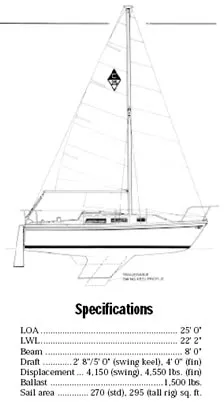
The Catalina 25 is not exceptionally fast, stylish, or spacious compared to newer widebody models, and while the construction and workmanship are adequate, they too are not exceptional. But because of the builders strict adherence to a philosophy of offering a relatively spacious design, relatively well made, at a reasonable price, and backing up the product with generally good customer service, the Catalina 25 has turned out to be one of the most successful small cruising sailboats ever built, with 5,332 boats sold between 1976 and 1990, when the company ceased producing the model as demand tailed off.
The Catalina 25 Design
During those 14 years of production, the design went through a complete metamorphosis, starting out as a very simple and inexpensive trailerable swing-keel design, and ending as a relatively sophisticated minicruiser. As vice-president and chief designer Gerry Douglas says, The last boats we built had diesel inboards, hot and cold pressure water systems, and extremely complex electrical systems. They were like little Catalina 34s. It was what people wanted in the late 1980s.
If you consider all model years, you can find Catalina 25s with five different keel configurations: cast iron swing-keel, cast iron fixed keel, cast lead wing keel, cast lead fin keel without glass jacket, and in later boats, a lead keel encased in fiberglass. In the later boats there was a choice of fin keel, wing keel, or swing keel, and standard rig or tall rig. However, the swing-keel model, with a board-up draft of 2′ 8″, accounted for well over half of total production. Most Catalina buyers over the years have been cruisers rather than performance-oriented racers, and for many cruisers, the attractiveness of a boat suitable for shoal waters and trailering is undeniable. Relatively few Catalina buyers are avid racers, it seems. If the hundred or so owners who answered our survey request are an indicator, only a small percentage rate as important either the fin keels much more efficient foil shape and lower turbulence, or the greater light-air efficiency of a two-foot longer tall rig mast that increases sail area by almost 10 percent.
As the design developed over time, features changed enough so that in a number of respects the early boats are very different than 1987 and later model years. As a consequence, its imperative for prospective buyers to know what model year theyre looking at when shopping for used boats. Prices can vary from less than $5,000 to more than $16,000, not only dependent on condition, but also model year and features.
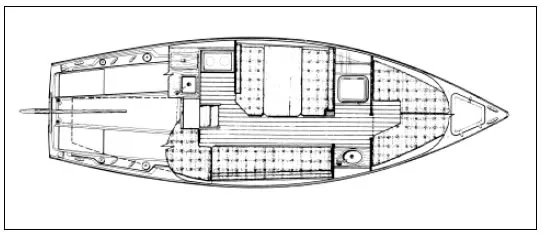
For example, at various times there was a choice of two different interiors: a dinette arrangement, and opposing settees. A flip-top (Catalinas version of the pop-top), which provided standing headroom, was a popular feature that was optional until 1987, at which time it became standard. In fact, in 1987 the entire boat underwent a major design change, yielding among other things a more contemporary deck and a more refined interior, with less teak and more fiberglass.
Performance and Handling of the Catalina 25
The Catalina 25, with a PHRF rating of around 228 for the standard rig or 222 for the tall rig, is not especially fast for its size. In fact, the swing-keel version, which is noticeably slower upwind than the fin-keel version, probably deserves an even higher time allowance than its been given. The fin keel is generally acknowledged to sail close to its rating, at least once the breeze pipes up to 10 knots or so. The swing keel is not as hydrodynamically sleek, and the keel lifting cable is out in the open where it causes extra drag, intensified if seaweed gets hung up on it.
The boat (especially the keel version) balances relatively well, tracks satisfactorily, and is quite maneuverable if sails are properly trimmed; it can be unforgiving if they are not. Several owners com plained to us of a heavy weather helm in a breeze.
The tall rig is a bit more tender than the standard rig, but definitely adds speed in light air. One just reefs a little earlier to maintain helm balance. But despite its virtues, the tall rig has a drawback mentioned by several owners: Unless you have a sailmaker chop off the bottom 12″ of the sail, the boom swings too low over the cockpit. This, however, may be the fault of some sailmakers; the consensus is that Catalina-supplied sails were not as well-made or well-shaped as those obtained from other sailmakers.
Under power, the Catalina 25 will make about 5- 1/2 knots with a 6-hp. outboard, and you can coax an extra 1/2 to 3/4 knot or so out of the boat with an 8- hp. or 9.9-hp. engine. (Theoretical maximum hull speed in ideal conditions is around 6.3 knots.)
The outboard is mounted on a fold-up transom bracket mounted off center to accommodate the outboard rudder. Some owners complained that the motor is difficult to raise and lower. Others observed that, in rough seas, when the boat pitches, an ordinary 20″ shaft outboard prop has a tendency to ventilate, particularly if the auxiliary is used under sail and the boat heels away from the side on which the engine is mounted. The owner consensus is that a 25″ extra long shaft largely solves that problem.
An inboard diesel engine would also solve the problem, but is not recommended; an owner of a 1986 model equipped with a 10-hp. Universal engine reports his boat is very slow under power, at least with the two-blade prop hes currently using. A three-blade prop might help, but would also significantly increase drag under sail.
Another disadvantage of the transom-mounted outboard is that its difficult for the helmsman to control. One owner who told us hed rigged remote engine controls in the cockpit said, Its the best thing weve done.
The boat needs to be reefed in 15 knots of wind (a jiffy reefing main was standard in later boats, though a roller furler for the jib was not). Above 15 knots, weather helm becomes very heavy if the main is left unreefed; one owner observed that she tends to round up in strong winds, or if heeled more than 15 degrees.
A short traveler is integrated into the stern pulpit, and although this works well while cruising, and
permits use of a bimini to protect crew from too much sun, mid-boom sheeting and a mid-cockpit traveler work better for single-handed daysailing and racing. Consequently, many owners have added the inboard traveler, some with a snap-on mainsheet block so they can switch back and forth.
A peculiarity of the design is that the distribution of the boats components evidently caused listing, in some boats to starboard, in others to port. For example, in the 1981 dinette model, owners complained that the dinette, engine, fuel tank, galley, and head were all on the port side, causing the boat to list noticeably to port. Catalina evidently took these complaints to heart, but the results were not totally effective; an owner of a 1982 model complained that batteries, holding tank, and outboard on the starboard side produced a list in that direction.
Other owner responses to our questionnaire included the following:
The absence of a bridge deck is a possible safety hazard when sailing offshore in a big following sea.
Narrow (7″ wide) sidedecks make going forward somewhat difficult. So do the 22″ high stanchions when the boat is heeled, impeding passage forward on the high side; shorter stanchions would help, but wouldnt be as safe.
The lifelines don’t lead to the top of the bow pulpit, but instead run to the deck at the bow to provide a slot for a deck-sweeping genoa. This can make the foredeck area insecure in adverse weather conditions. Bails on the top of the pulpit and pelican hooks on the lifelines would be an improvement, since it would then be possible to raise the lifelines in heavy weather or when a high-clew jib is being used.

Catalina 25 Interior
Compared to other boats available in the 1970s an early 1980s, the Catalina 25 is relatively spacious below, though some readers complained that the aft double is really only a single quarter berth and that the port side settee berth is not long enough for an adult. Newer beamier designs, of course, have the advantage of more elbow room below.
At least one owner improved sleeping accommodations by building a plywood platform which fits between the table on the port side and the settee on the starboard. The aft berth cushion, under the cockpit sole, was shortened slightly to fit on this platform. When in place, the platform results in an athwartships berth about 6′ 4″ long and 5′ 1″ wide, big enough for a double sleeping bag. When not in use, the plywood platform stows on the aft berth.

Light and ventilation below is very adequate, as long as theres a breeze from forward. Because the forward hatch slopes down the forward edge of the cabin trunk, when open it becomes a very effective windscoop. Boats with pop-tops have additional ventilation.
The pop-top was an extra-cost option, and a very popular one. Reader praise of the pop-top is almost universal, with comments from Buyer interest is much higher on boats with pop-tops to Contrary to what some folks say, this pop-top does not leak in the rain or spray. Headroom is 6′ 4″ with the pop-top raised.
Until the 1983 model year, when the company redesigned the icebox so it would, as one owner reported, keep block ice for three days, the icebox was severely under-insulated; many owners reported that it would only hold ice for less than a day. Another complaint was that the icebox drains directly overboard, and as a consequence, if the drain is left open when the boat heels, water enters the icebox. One reader killed two birds with one stone: We keep our trash in the built-in cooler where it is out of sight, and use an Igloo cooler which is bigger and works better.
Construction of the Catalina 25
The Catalina 25 has a full fiberglass hull liner, which makes it easier to keep the boat clean but at the same time can make repairs and adding owner-installed custom components more difficult.
Several owners judged that Florida-built Catalina 25 hulls, though adequate in strength, are not as well finished as the California-built boats. And several others commented on gel coat chipping and cracking, voids, pits, and crazing, particularly in stressed areas such as at sharp changes of direction in the cockpit, and corners of hatch covers, though these problems didnt seem to be a function of builder location.
Bottom blistering seems to have been a fairly common problem on Catalina 25s when an epoxy bottom coat had not been applied under the antifouling paint to prevent water incursion. Catalina now has a 10-year no-blister warranty, but during the era of the Catalina 25, the company had a five-year warranty with gradually diminishing payments during the period. Judging from reader response to our questionnaire, some owners were not entirely satisfied with that arrangement.
In the swing-keel version, Catalina used an ordinary galvanized steel trailer winch to hoist the keel, and although there are no doubt some 20-year-old boats that still have the original winch, many owners have had to repair or replace some or all of it, particularly when the boat is sailed in saltwater.
Another problem with early swing keel models involved breaking the pennant. At the lifting point on the trailing edge of the swing-keel there is a tapped hole on a flat area into which screws a stainless steel eye. A swaged fork fits over the eye and pivots on it as the keel swings up or down. The factory fixed the eye in place with Loctite, but over the years the eye could rotate, so that the clevis pin became parallel to the keel instead of perpendicular to it. Then it would bind, and eventually end up bending and then breaking the wire at the joint of the wire and the swaged fitting. To solve the problem, Catalina came up with a device to keep the eye from rotating, but some older boats may not be retrofitted. Owners and prospective buyers of older boats should examine the swing keel to be sure the eye is solidly fixed in place.
Several owners complained that there is no mechanical lock to stop movement of the swing keel,
which even at anchor can move laterally in its trunk, banging, thumping, and making it, according to one owner, hard to sleep through the night. Catalina offers a retrofit kit to alleviate the problem, composed of nylon or neoprene washers -but according to some owners, this cure is only partially effective.
The surface of the cast iron swing keel was said by some of the performance-oriented owners to be comparatively rough as it came from the factory. They advise filling and sanding fair and smooth for better sailing speed. We would add that the keel should be checked regularly for corrosion, and an epoxy barrier coat should be maintained on the surface to prevent excessive rusting and deterioration.
Deck and cabin hardware, while generally adequate, is considered sub-par by some owners, particularly on the early models. For example, the type of closed-barrel turnbuckles Catalina used are hard to inspect without disassembly, and as a result tend to corrode internally, sometimes freezing or completely failing. Later models have the open-barrel type, which is preferable.
The forward hatch for several model years was attached with self-tapping screws rather than throughbolted, causing the hatch to become loose in some cases. By 1983, bolts had replaced the screws. Other relatively common complaints include rusty screws on deck fittings, broken boom goosenecks, insufficient bow eye backing plates, tillers splitting (on one boat the tiller split twice), and problems with rudders delaminating and splitting along the edge.
A particularly common problem noted is that rudder gudgeons and pintles break or come adrift
from the transom. The repair involves installing a handhole inspection port on the inside of the transom to gain access to the fastening bolts. One reader said his lower pintle had broken under racing conditions, but that he had cured the problem by adding a third pintle and gudgeon halfway between the top and bottom fittings.
Several other readers reported that their boats had loose gudgeon bolts, stress cracks in the transom at the gudgeon attachment points, and transom leaks. One owner reported the transom cracked below the motor bracket because of lack of reinforcement behind the bracket.
The hull-deck joint on some models used selftapping screws rather than through-bolts. Several readers experienced rain and spray leaks along the rail. Portlights also have been a source of leakage problems, as have cockpit scuppers, rudder gudgeons, and various pieces of dealer-installed deck hardware, mostly due, we guess, to inadequate bedding procedures and backup plates.
Trailering the Catalina 25
Despite the fact that a bare Catalina 25 weighs approximately 4,150 lbs., the boat plus trailer, loaded for a weeks cruise, can easily weigh over 6,000 pounds. That means its necessary to tow with a big pickup or van equipped with a towing package, and virtually eliminates prospective trailer-sailors who only have access to an ordinary passenger vehicle, no matter how powerful. (An exception: Big cars built before the advent of downsizing and integral frames. For example, one reader says he pulls his 6,000-lb. rig successfully with a 1973 Olds 98).
The Catalina 25s mast is deck-stepped on a hinge, but several readers complained that no factory method is offered to make mast-raising safer and easier. Still, some owners have devised their own systems, with which they seem to be satisfied. One who made extensive modifications figures it takes him a mere 45 to 60 minutes from the time he pulls into the parking lot at the launching ramp until hes sailing away-and only a little longer than that to reverse the procedure.
One reader pointed out that with the swing keel model the rudder is deeper than the retracted keel (unless its a folding rudder, which Catalina offered as an option in some model years), which can produce problems at the launching ramp under some conditions. Another owner feels that his fin-keel is as easy to ramp-launch as a swing keel, provided an extra-long trailer tongue extension is used. We think that might be true on some ramps, but not on others.
If youre shopping for a Catalina 25 already equipped with a trailer, check the GVWR (Gross
Vehicle Weight Rating) decal before you buy. It indicates the loaded weight of the trailer in pounds, i.e. the sum of the carrying capacity of the trailer plus the weight of the trailer itself. One reader ordered (from a Florida dealer) and paid for a trailer with a 7,000 lb. capacity rating. What he got was one rated for only 5,000 lbs. He was prompted to check the decal because, he says, The trailer looked skimpy. He weighed the combination with the boat stripped and it came to 5,620 lbs. The dealer claimed it was the same trailer they always use for this boat an the dealer passed me off to the Florida plant, who passed me off to the trailer manufacturer, who finally made good after Frank Butler got into the act-after seven months of hassling.
New or unseasoned sailors making their first or second foray into the boat-buying game may find that the Catalina 25 is an attractive choice. The boat is relatively easy to handle, can be single-handed without too much trouble, and while not fast in the racing sense, is fast enough to satisfy many cruisers. The interior is big enough for two to cruise in relative comfort, while the overall size of the boat is not daunting to most newcomers to the sport. Other advantages for new sailors are that Catalina, in most cases, does a good job with customer service, and theres a quarterly 100-page glossy publication for all Catalina owners (from 8′ Sabots to all the way to Catalina 42s) called Mainsheet which offers support and helps to keep communications open between owners.
Asking prices on used Catalina 25s range from around $4,000 for older (late 1970s) models that probably need some work, to around $16,000 for newish (late 1980s) models fully equipped and in like-new condition, probably with an inboard engine and a trailer included. A price of $7,000 to
$8,000 is typical for early to mid-1980s boats, though we noticed a wide range, presumably based on condition and accessories.
Prospective buyers should check for bottom blisters (which can be expensive to repair), evidence of problems around the keel bolts or pivot on the swing keel, rudder connection problems, cracks in turnbuckles or rigging terminals, leaks around windows and hull-deck connection, and other common (and correctable) flaws.
Also check for which of the many extra-cost options have been installed-options which many experienced sailors would say should have been standard: boom vang, genoa winches, pop-top with canvas enclosure (originally two separate options), basic electrical system with running lights and cabin lights, galley equipment, head, lifelines and stanchions, and sails. Check especially the brand of sails; many readers report that they have been dissatisfied with Catalinas own brand of sails.
Overall, we think the Catalina 25 is not fancy or fast, but is economical, a fair sailer, and roomy for its size-a good boat for non-racers who don’t have a big budget and for relatively new sailors who want to get their feet wet in the sport.
RELATED ARTICLES MORE FROM AUTHOR
12 comments.
Mr Nicholson,
Thank you for the report on the Catalina “25” I’ve Been searching for an older (less expensive) under 30’ single handed sailboat for the past several months and finally today someone posted a Catalina 25’ on buy, sell, or trade in the Destin Florida area. The elder gentleman wanted to restore it but a bad hip has preventing that, so he sold it to me. I started sailing about 20 years ago with a Balboa 27’ with a swing keel (what a life saver). Lost it in the divorce. There are many sand banks and shoals here in Choctawhatchee Bay and a swing keel is what a newbie needs. I don’t think this Catalina has a swing keel, at least I don’t see the crank in the cabin. The ships dimensions in your report help immensely. I have not done an inventory yet on board (they left a lot of stuff) I hoping the main is useable and I have already inspected and cleaned the storm jib, I don’t see a Genoa (Bimini) or any other jib sail hidden away. Anyways, thanks for your report I look forward to getting it under sail.
We’ve had a 1985 Catalina 25 swing keel since 2006. I’ve sailed a lot of different boats over more than fifty years. This boat has been a good investment for fun and reliability. I’ve never reefed in the near fifteen years sailing it on the Monterey Bay. We’ve burried the rails on more than one occasion and while it does weather helm in heavy winds, it’s easily managed and I’ve never been worried about a knockdown.
Have 1985 Catalina 25 swing keel, #K4978. I don’t know if it’s the standard or tall rig. Can I tell from the HIN#?
i am new owner of a 25ft 1981 catalina and i need 1 simple measurement .. height of wing keel from the bottom of keel to the bottom of the boat as i am building a trailer to get it home with..
sorry fin keel
I am looking to buy a fixed keel Catalina 25. The keel seems short ar 4 ft when I would have expected 5 ft for a boat this size. My question is does this make the boat more tender with ballast less lower in the keel. And how does this affect performance say against the swing keel model
Did you get to sail ‘er this summer? We have a 1980 fin keel and as long as your co-captain doesn’t mind 10 to 15 degree heel, you’re not afraid to reef the main in a blow and you’re not sailing in a hurricane, you’ll find that 4 feet of keel is plenty.
Hi Peter, We’ve had our 1986 C25 SR SK for four years now. Our mooring mates have an 81 TR FK and we oftentimes run them together. While the Tall Rig makes theirs a little tender, proper trim seems to mitigate most puffs. As for our Swing Keel, typically deployed fully, we notice we cannot point as high but routinely we are keeping up around 6kts. I do notice in the SK, with the other owners aboard, that we have gain positive comments for our sails so I guess that is where you have a tough time making scientific comparisons, lots of variables. We have an even less fair comparison, a C25 Capri who has newer nicer sails and a seasoned skipper who wins most regattas and that fin easily allows him to point with a larger sail plan. The more I write, the less I think this will help you; however, for a swing keel, we’re plenty happy from a non-competitive perspective and don’t have envy/regrets when looking on those with fixed.
We have a Catalina 25 from 1983. We are in a humid area. We love the boat! Our son wants to add an air conditioner of some form to make it more tolerable to sleep on hot nights. I do not want to overwhelm the interior where I sit at the table to prepare meals and do artwork. What suggestions might you have for our situation? Thank you!
Pardon it is an 89 not an 83 Catalina !
I have a 1985 22ft and the cable for the keel broke can this be loaded onto a trailer?
LEAVE A REPLY Cancel reply
Log in to leave a comment
Latest Videos
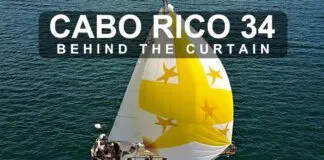
Cabo Rico 34 Boat Review

Super Shallow Draft Sailboat: The Leeboard Sharpie

Hans Christian 41T – Boat Review

Seven dead after superyacht sinks off Sicily. Was the crew at...
Latest sailboat review.
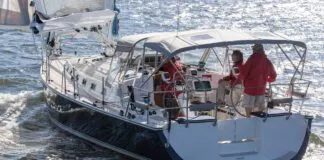
- Privacy Policy
- Do Not Sell My Personal Information
- Online Account Activation
- Privacy Manager
- Articles and Guides
Catalina 30 Review: Features, Performance and Tech Specs
7th feb 2024 by john burnham / samantha wilson.

The Catalina 30 has had a long and illustrious life and remains to this day a favorite on the used market. Over 6,400 Catalina 30s were sold during its 25-year production run starting in 1974, testament to its solid construction, functional layout, ease of sailing, a modest price, and the strong Catalina dealer network.
So what makes it so popular? While it’s not really intended as a bluewater cruiser, the Catalina 30 handles coastal and inshore sailing with ease. It is ideal for weekends or week-long cruises thanks to its cleverly thought-out interior space. Overall, the Catalina 30 sails well, is a stable design in stiffer winds, and can be sailed single-handedly by a competent skipper.
Despite several versions throughout its production run, including the MKII, first built in 1986, and the MKIII, in 1994, the basic dimensions of the model remained unchanged: LOA 29’11", beam 10’10", displacement 10,200 lbs., and standard draft 5’3". Likewise, the interior was never altered. Catalina’s approach to the huge success of the 30 seemed to be ‘if it ain’t broke, don’t fix it!’.
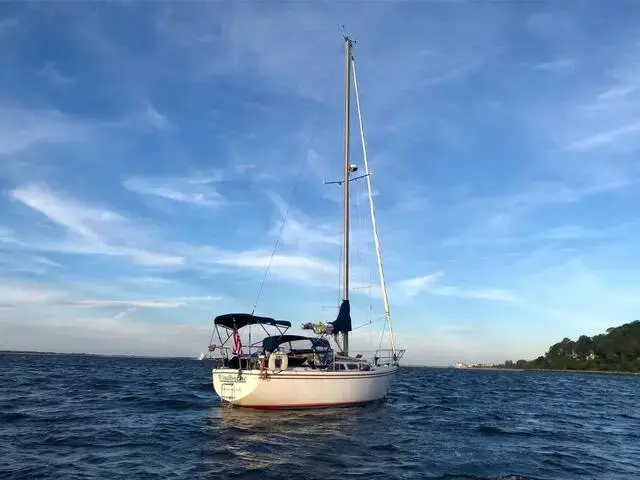
Catalina 30. Rightboat seller photo.
Catalina 30 Key Features
There have been many versions of the Catalina 30 throughout its long production run, with different configurations. There have been standard and tall rigs, each with a bowsprit option, as well as shoal, wing, and deep fin keels. Following on from the MKII in 1986, the MKIII in 1994 made some noticeable changes, namely a slight widening of the hull aft, which allowed for a transom boarding platform.
The Catalina 30’s hull, like all of Catalina’s models, is built of fiberglass and polyester resin, with a deck constructed of either balsa or plywood between fiberglass laminates. Belowdecks, the Catalina 30s layout remained unchanged throughout its life. With a wide companionway creating a spacious feel to the cabin, able to accommodate up to four with a separate head, large galley, and cozy saloon, it proved popular and user-friendly. The boat has an aft cockpit with a closed transom.
While this model undoubtedly ticked a lot of boxes for many sailors, it had a few common problems, as described in various owners forums. Compression fatigue at the maststep on deck and in the bilge under the compression post has been commonly reported over the years and may need to be fixed. Likewise, old wooden spreaders sometimes fail, and leaks and separation may be experienced at the keel-to-hull joint. Ensuring these are all inspected in a thorough marine survey when buying will highlight any issues the boat might have.
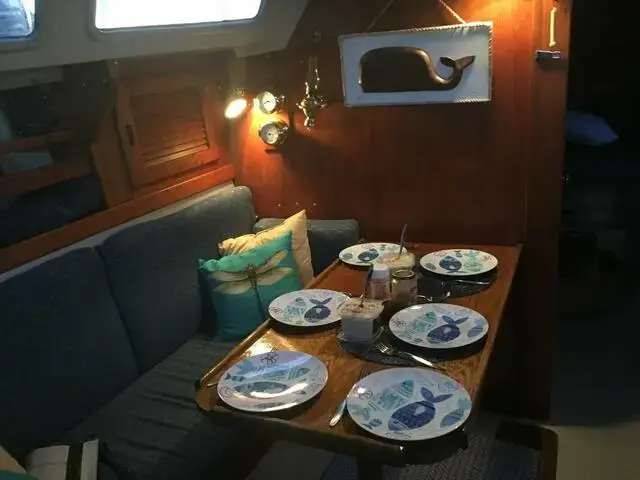
Catalina 30s spacious interior with separate cabin and dinette. Rightboat seller photo.
Catalina 30 Performance
The Catalina 30 impressively straddles the line between performance and comfort, offering decent speeds compared to competitors of the same era, despite a lower sail/displacement ratio of 15.22. The fin keel version has deeper draft, lowering the center of gravity and providing better performance upwind. A higher ballast/displacement ratio means the Catalina 30 stands up well in stronger winds.
Catalina 30 Why Buy It
- One of the top-selling 30-foot sailboats ever
- Spacious accommodation for up to 4 people including saloon and galley
- Wide, deep hull creates exceptional space above and below decks
- Known for its stability under sail
- Variety of models and variations to be found on the used market
- Good value for money on the used market with lots in circulation
- Buying used?: Possibly compromised deck cores and mast steps merit checking before purchase. For other tips when buying a used boat, read our Boat Inspection Checklist
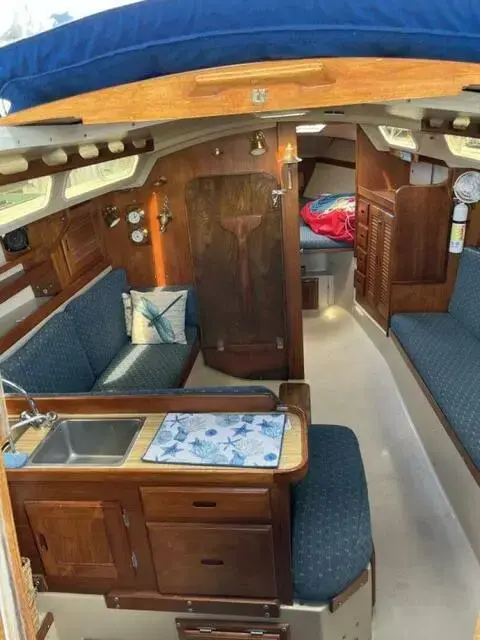
Galley and saloon of Catalina 30. Rightboat seller photo.
Catalina 30 Technical Specifications
- LOA: 29.92 ft
- Beam: 10.83 ft
- Draft: 5.25 ft
- Rigging Type: Masthead sloop
- Hull type: Fin w/spade rudder
- Displacement: 10200.78 lbs
- Ballast: 4200 lbs
- Ballast type: Lead
- Fuel tank capacity: 21 gallons
- Sail area/displacement ratio: 15.22
- Ballast/displacement ratio: 41.18
- Critical hull speed: 6.70 knots
- Engines (after mid-1980s): 3-cylinder Universal M-25 diesel engine

Enclosed cockpit and seating of Catalina 30. Rightboat seller photo.
Check out all the Catalina boats for sale
Written By: John Burnham / Samantha Wilson
John Burnham is a marine editor and writer with decades of journalism experience as Chief Editor of boats.com, Sailing World, Cruising World, and other boating websites. As a competitive sailor, he has led teams to world and national titles in the International One-Design, Shields, and other classes. Based in Newport, Rhode Island, John is a PCC leadership coach, a member of the America’s Cup Hall of Fame Selection Committee, and a past board member of Sail America and US Sailing. For more, see johnsburnham.com .
Samantha Wilson has spent her entire life on and around boats, from tiny sailing dinghies all the way up to superyachts. She writes for many boating and yachting publications, top charter agencies, and some of the largest travel businesses in the industry, combining her knowledge and passion of boating, travel and writing to create topical, useful and engaging content.
More from: John Burnham / Samantha Wilson
Related Articles and Guides
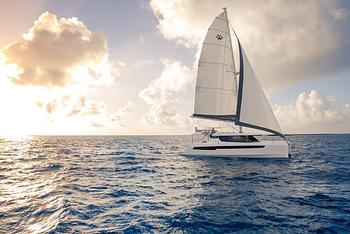
3rd Jul 2024
Leopard 50 Review: Innovative, Versatile, Practical
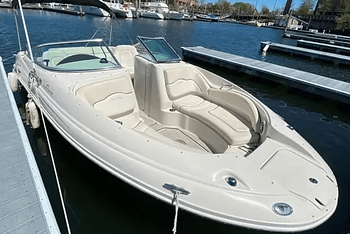
14th May 2024
Sea Ray 220 Sundeck, Much More Than a Bowrider
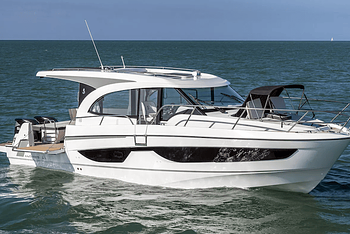
21st Apr 2024
Beneteau Antares 11 Review: Features, Performance and Tech Specs
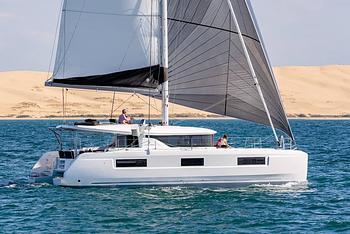
31st Mar 2024
Lagoon 46 Review, Spacious Bluewater Catamaran

- Explore Rightboat
- Boats for Sale
- Boating Articles
- Buyers Guide
- About RightBoat
- Sell Your Boat
- Boat Selling Advice
- All manufacturers
- All categories
- Are you a broker/dealer?
- Learn more about the Rightboat:HUB
Enter your email to keep up to date with the latest news
Join for free
Sign up now for free and discover how easy it is to keep up to date with THE latest boats for sale. Find your right boat, and tailor your voyage to finding your next boat.
Benefits of becoming a member:
- Set up tailored alerts
- Personalise your experience
- Download full specifications and broker details
- Keep tabs on your favourite boats
Are you a broker? Join as a Broker
Rightboat - join for free.
Do you have an account already? Login
Save this search
Save your search and receive new boats in your email..
You can unsubscribe from your alerts whenever you like. By pressing the button you accept the Legal Terms and conditions


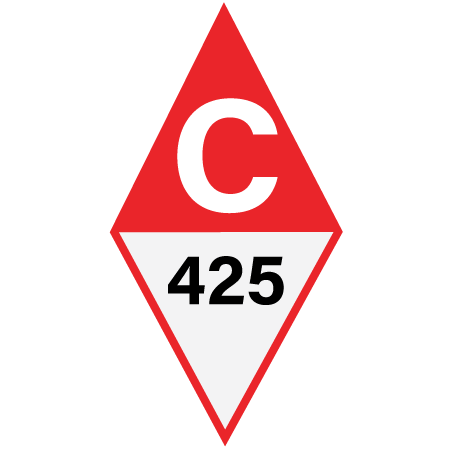
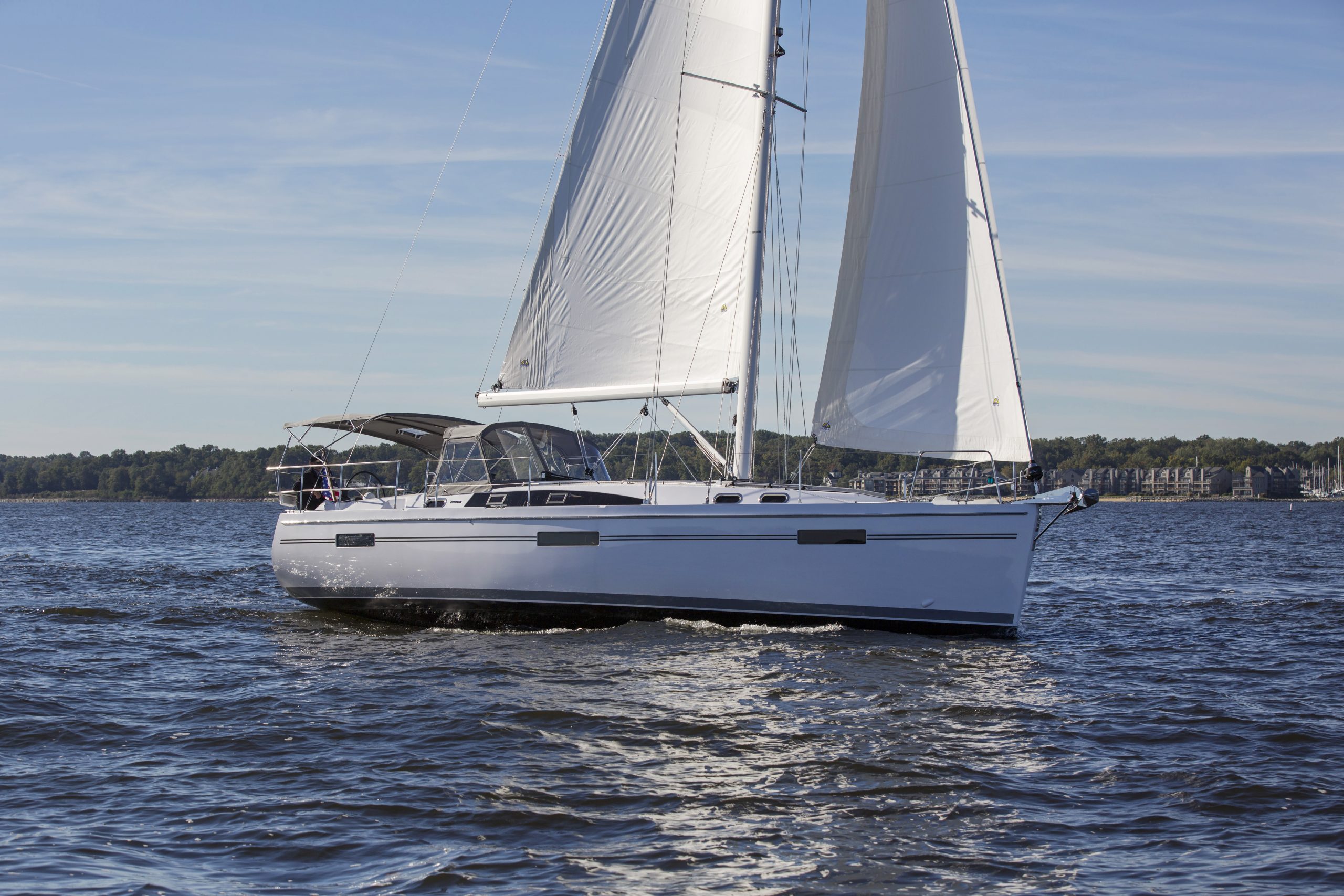
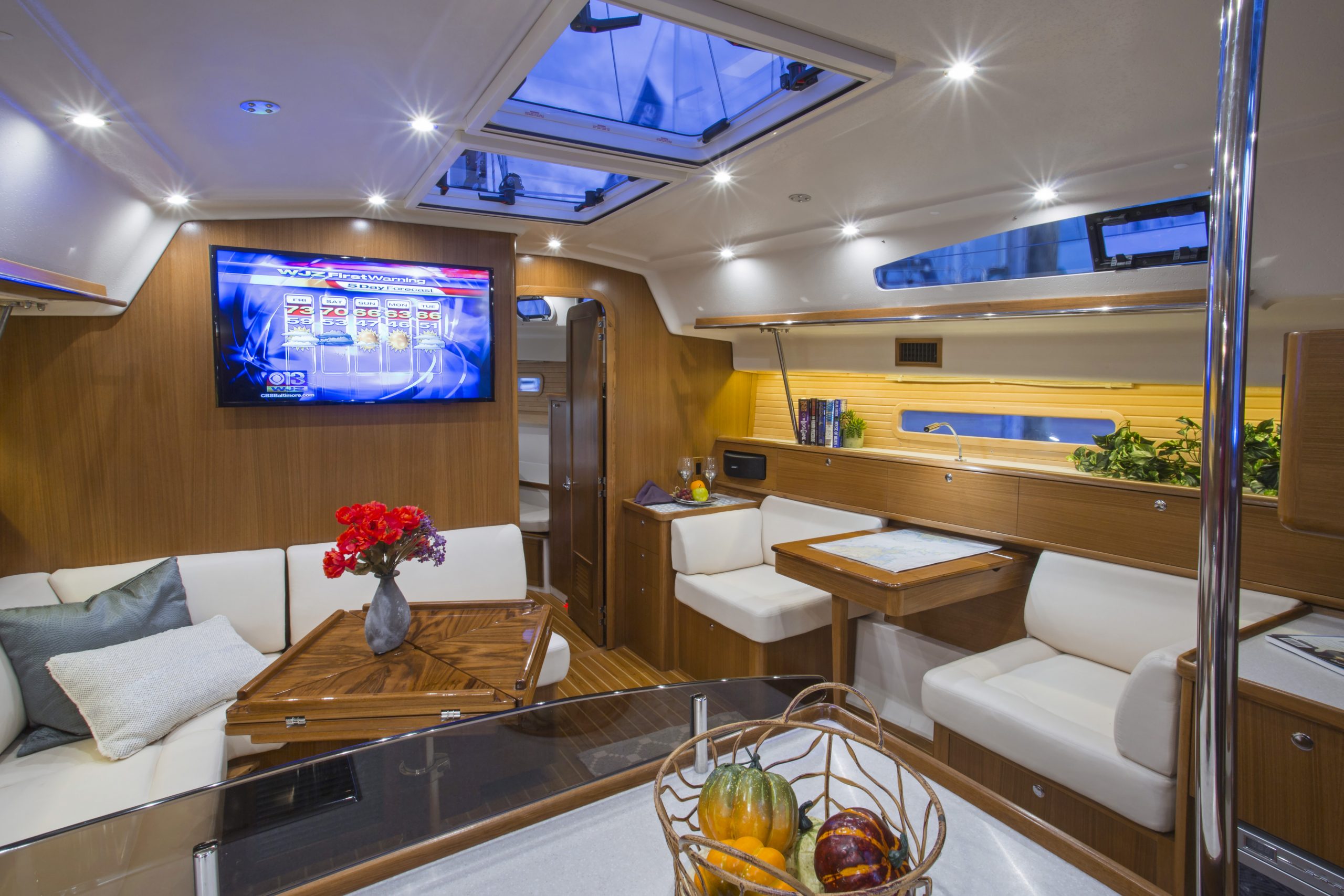
COMMENTS
Find Chris-craft Catalina 29 boats for sale in your area & across the world on YachtWorld. Offering the best selection of chris-craft boats to choose from. ... ft. m. Price. to. USD. Year. to. Class. Power. Power-all-power. All power. Power-center-console. Center Console. ... 2015 Chris-Craft Catalina 29. US$139,000. ↓ Price Drop. US $1,056 ...
Catalina preowned sailboats for sale by owner. Catalina used sailboats for sale by owner. Home. Register & Post. View All Sailboats. Search. ... 28.58' Ericson 29 foot sloop Madison County FL, Florida Asking $2,000. 30' Pearson Wanderer Northport, Michigan Asking $9,000. 30' S2 9.1 Mamaroneck, New York Asking $5,000.
ft. m. Price. to. USD. Year. to. Class. Power. Power-all-power. All power. Power-cruiser. Cruiser. Power-other. Other. ... Catalina boats for sale on YachtWorld are offered at a range of prices from $7,837 on the relatively lower-priced models, with costs up to $480,463 for the highly-specialized, bespoke models. ... Catalina 30 29 listings ...
The starting price is $104,000, the most expensive is $209,000, and the average price of $134,250. Related boats include the following models: Launch 27, Launch 25 GT and Catalina 30. Boat Trader works with thousands of boat dealers and brokers to bring you one of the largest collections of Chris-Craft 29 catalina boats on the market.
FORGING AHEAD. From the past 50 years, and to the next 50, Catalina is devoted to providing owners and dealers with quality and value that has made Catalina America's largest sailboat builder. Frank Butler's vision and philosophy carries forward with Sharon Day, who worked alongside Frank for 48 years, at the helm of a veteran leadership team.
Find Catalina 30 boats for sale in your area & across the world on YachtWorld. Offering the best selection of Catalina boats to choose from.
Known for its sweet sailing performance in nearly all conditions, the Catalina Capri 22 has been winning sailors since its introduction. The Capri 22 is more comfortable, safer at sea and easier to maintain than any boat in its class. The striking deck profile is flared across the stern and has wider cockpit curves for crew comfort during and ...
29.92 ft / 9.12 m: LWL: 25.00 ft / 7.62 m: S.A. (reported): ... Related Sailboats: CATALINA 30 MKII : CATALINA 30 MKIII : Download Boat Record: Notes. With more than 6000 sold, the Catalina 30 is one of the most successful production sailing yachts in history. During the long production run of this basic model there were a great number of ...
View a wide selection of Catalina 30 boats for sale in ... voluminous 30 ft sailboat that is just as suitable for exploring as it is for extended cruising. Simple in design, layout , and appointments, the Catalina 30 checks a lot of boxes for a lot of sailors. ... better tracking, and higher pointing. LOA: 29.92 ft Beam: 10.83 ft Draft: 5.25 ft ...
Presenting the all-new Catalina 355, a new hull design with a long waterline, moderate beam and freeboard, and a handsome low-profile cabin structure. Everywhere you look on the 355, you'll find features that make sailing for the day or for extended periods a pure pleasure. Precise mainsail control is a snap with a 5′ long traveler.
The Chris-Craft Catalina 29 proves that center console and fishing don't necessarily have to go hand in hand. When I first rode the Chris-Craft Catalina 26 and wrote up the boat review I tried to make the point that its fishing ability was surprisingly good for a boat with so much emphasis on panache, and while I might say the same thing ...
Find 28 Catalina 30 boats for sale near you, including boat prices, photos, and more. Locate Catalina boat dealers and find your boat at Boat Trader!
Under power, the Catalina 25 will make about 5- 1/2 knots with a 6-hp. outboard, and you can coax an extra 1/2 to 3/4 knot or so out of the boat with an 8- hp. or 9.9-hp. engine. (Theoretical maximum hull speed in ideal conditions is around 6.3 knots.)
The Catalina 30 impressively straddles the line between performance and comfort, offering decent speeds compared to competitors of the same era, despite a lower sail/displacement ratio of 15.22. The fin keel version has deeper draft, lowering the center of gravity and providing better performance upwind. A higher ballast/displacement ratio ...
Founded by Frank Butler. In sheer numbers sold, Catalina Yachts is certainly the most successful builder of sailboats ever in the US, and possibly the world. Time line extract from the company's website: July 1969-Catalina's first model, the Catalina 22, is built in North Hollywood, CA. Company owner Frank Butler hopes to build 100 boats if all goes well. March 1970-Catalina's second ...
Find 29 Catalina Yachts for sale in Florida, including boat prices, photos, and more. Locate Catalina boat dealers in FL and find your boat at Boat Trader!
Catalina is a boat builder in the marine industry that offers boats for sale in differing sizes on Boat Trader, with the smallest current boat listed at 20 feet in length, to the longest vessel measuring in at 47 feet, and an average length of 34.51 feet. Boat Trader currently has 189 Catalina boats for sale, including 17 new vessels and 172 ...
catalina preowned sailboats for sale by owner. catalina used sailboats for sale by owner. Home. Register & Post. View All Sailboats. Search. ... 28.58' Ericson 29 foot sloop Madison County FL, Florida Asking $2,000. 30' S2 9.1 Mamaroneck, New York Asking $5,000. 30' Pearson Wanderer Northport, Michigan Asking $9,000.
The Catalina 425 is an all-new design that assumes the position in the Catalina line held by the legendary Catalina 42. Although it is new and contemporary in styling it is designed to endure in function and aesthetics in the Catalina tradition. ... 429 ft 2. Main by Measurement: 436 ft 2. Total w/100%: 865 ft 2. Sail Area - Displacement Wing ...
1992. $99,000. 1992 Catalina 42 ready to cruise! Fantastic example of an excellent design, the Catalina 42 has a rich history in the long range, cruising several certain navigations and local club racing. CAROLINE is a 2 cabin, pullman berth layout with 2 heads. She is extremely well equipped for live-aboard cruising and is turn-key ready to go.
36.29 ft / 11.06 m: Sailboat Links. Designers: Frank W. Butler: Robert Finch: Builders: ... In it's first 3 years of production nearly 1500 boats were sold. Total production was 6662 hulls. Offered originally with a std. outboard well, in 1973, Catalina offered an inboard Atomic 4 engine as an option and over the years a number of other engines ...
It takes into consideration "reported" sail area, displacement and length at waterline. The higher the number the faster speed prediction for the boat. A cat with a number 0.6 is likely to sail 6kts in 10kts wind, a cat with a number of 0.7 is likely to sail at 7kts in 10kts wind. KSP = (Lwl*SA÷D)^0.5*0.5